How does Iowa corn impact Iowans and the world?
Iowa leads the United States in corn production. The state set a record in 2016 with 2.7 billion bushels, slightly ahead of 2017 and 2018 levels. In 2018, however, the estimated yield set an all-time high at 204 bushels. Iowa's incredibly fertile fields of north central Iowa stretch for miles of corn and soybeans, providing the United States with two of their most valuable exports.
History of Corn and Iowa
Corn has been at the center of Iowa life for almost a thousand years. The ancestors of our modern corn plants first appeared in Central Mexico as a tiny ear wrapped in a tight husk. Through careful cultivation, mostly by American Indian women, the plant eventually evolved into size and shape we know it today. It spread into what is today the American Southwest, along the Gulf Coast and up the Mississippi River and its tributaries until it was a staple of the Upper Midwest and most tribes east of the Mississippi. English colonists first encountered it with the tribes they met on the Atlantic Coast from New England south to Georgia. Corn cultivation had a major impact on the seasonal activities of those who planted it. The year revolved around spring planting and fall harvest, often with the celebration of a successful crop marked with annual festivals. In Iowa pioneer times, farm boys could often attend school only in the winter because their labor was needed at home for planting, cultivation and the fall harvest.
Corn is a giant grass plant and, therefore, easily adapted to the fertile plains of the Iowa prairies. It is incredibly productive as one kernel planted will produce one or two ears with 700+ kernels each. Hybrid varieties developed and spread in the 1920s and 1930s proved so successful that most Iowa farms had adopted them for the end of World War II. Plants grown from hybrids, however, lack the vigor of the parents, creating an annual market and a very profitable hybrid seed industry for the state.
Because corn is bulky, farmers learned early that it is more profitable to feed their corn to livestock, primarily hogs, and then market "the corn" as pork. The Corn Belt corn/hogs economy developed in the late 19th century when the railroad lines connected midwestern farmers with eastern markets. Most of the corn grown in Iowa is what called "field corn." Only one percent of corn planted in the United States is sweet corn. Almost all field corn is used for animal feeds, the production of ethanol as a fuel for automobiles and for manufacturing in products like plastics.
Corn's Effect on Farming Practices
Farm practices have evolved radically since early American Indians and pioneer times. An early technique was to dig a small hole with a hoe and to drop in three to five kernels. Indians often planted beans and squash around the corn to allow the vines to grow up the corn stalks. Weeds were chopped out during the growing season. The labor required kept fields small. The introduction of horse-drawn plows and planters in the mid-19th century allowed one farmer to cultivate much larger fields. The mud and clay scoured ("slid off") John Deere's steel plowshare, saving the time the farmer had to stop and remove the sticky soil. With the tractor in the early 20th century and the mechanical corn picker, field sizes again took a major leap.
Agriculture has been a major occupation of Iowans and corn has been the most significant product. Iowa is truly a product of this incredible grain.
Supporting Questions
How has farming in Iowa seen continuity and change?
- Average Farm Size in Iowa Map, 1933 (Map)
- Corn Yield Map of Iowa, 1933 (Map)
- Farmer Working a Corn Field with a John Deere Tractor, ca. 1945 (Image)
- Field Workers Harvesting Sweet Corn in Grimes, Iowa, August 1946 (Image)
- Number of Farms and Average Farm Size in Iowa from 1950 to 2014, 2015 (Document)
- Corn for Grain Yield Map of Iowa, 2018 (Map)
- Gulls Following a Farmer on his Tractor, Date Unknown (Image)
What impact did John Deere have on farming in Iowa?
- "The Hawkeye Cultivator," 1863 (Document)
- Gilpin Sulky Plow Patent, 1875 (Document)
- "The Original Steel Plow” and John Deere, 1882 (Document, Image)
- "A Short Interview" with John Deere, ca. 1886 (Document)
- New Deal Gang Plow with Traction Engine Advertisement from John Deere, 1889 (Document)
- Brochure about John Deere's Gilpin Sulky Plow, 1895 (Document)
- Aerial View of the John Deere Tractor Company in Waterloo, Iowa, 1944 (Image)
- Farmer Operating Corn Picker with John Deere Tractor, ca. 1945 (Image)
Where does Iowa corn go and how is it used?
- Flowchart of U.S. Agricultural Supply Chain for Raw and Processed Products, 2009 (Document)
- Flowchart Showing the Uses of Corn, 2009 (Document)
- "Percent of Total U.S. Corn Exports by Country" Graph, 2017 (Document)
- "Compare... Cargo Capacity" Infographic, February 25, 2019 (Document)
What is Iowa Sister States’ role in global agricultural opportunities?
- Iowa Hog Lift to Japan, 1960 (Image)
- Lee Norris' Truck Loaded with Hogs, 1960 (Image)
- Letter from Governor Herschel Loveless to Lee Norris about the Hog Lift, January 18, 1960 (Document)
- Speech by Governor Norman Erbe on the Dedication of the Japanese Friendship Bell, October 17, 1962 (Document)
- Governor of Yamanashi, Japan, Asking Citizens to Help Iowans Suffering from Flood Damage, 1993 (Document)
- "The 1960 Hog Lift," 2001 (Document)
- "Iowa Sister States Agriculture Impact," 2019 (Document)
| Iowa's Corn and Agriculture Industry Teaching Guide |
| Printable Image and Document Guide |
"The 1960 Hog Lift," 2001
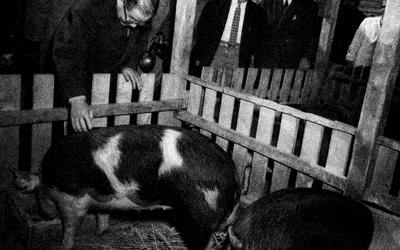
Description
In a feature article in Iowa Heritage Illustrated from 2001, Ginalie Swaim writes how Master Sergeant Richard Thomas, a Des Moines native who was stationed with the U.S. Air Force in Japan, heard about two terrible typhoons in Yamanashi and mobilized a group…
Letter from Governor Herschel Loveless to Lee Norris about the Hog Lift, January 18, 1960
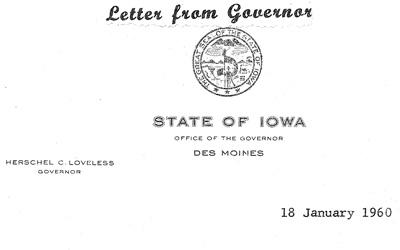
Description
Governor Herschel Loveless was present when the hogs were loaded onto the U.S. Air Force cargo plane bound for Japan in 1960. In this letter, Governor Loveless thanks Lee Norris for his involvement in the hog lift. Norris provided seven of the 39 hogs that were sent to…
Speech by Governor Norman Erbe on the Dedication of the Japanese Friendship Bell, October 17, 1962

Description
The Bell of Peace and Friendship was given as a gift from the Yamanashi Province in Japan to the people of Iowa in 1962, about two and a half years after the 1960 hog lift from Iowa to Yamanashi. This is Iowa Governor Norman Erbe's speech at the dedication ceremony on the…
Governor of Yamanashi, Japan, Asking Citizens to Help Iowans Suffering from Flood Damage, 1993
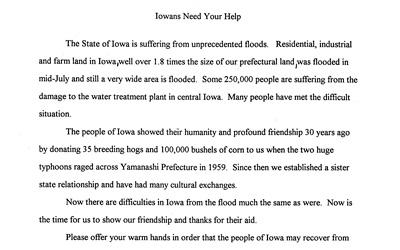
Description
Governor Terry Branstad invited Governor Ken Amano of Yamanashi, Japan, to visit Iowa in May 1993 to attend the Iowa State Fair. At that time, Branstad had no way of knowing the devastating flood that would impact thousands across the state of Iowa in 1993…
"Iowa Sister States Agriculture Impact," 2019

Description
Founded in 1985, the Iowa Sister States organization has worked to connect Iowa culture and agriculture with "sister cities" in nine countries around the world. The organization hosts exchange programs with Iowans visiting these sister cities, as well as groups from the…
Average Farm Size in Iowa Map, 1933
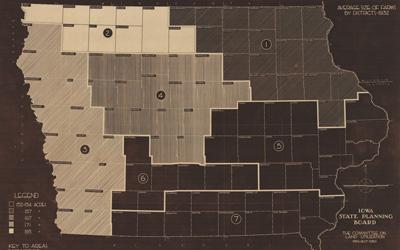
Description
In 1933, the State Planning Board of Iowa, a special committee that only existed from 1934 to 1939 to study long-term land use plans for the state, published this map showing the average farm size measured in number of acres. They also showed if the land was used for cash…
Corn Yield Map of Iowa, 1933
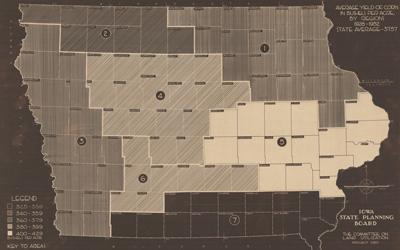
Description
Each year, the United States Department of Agriculture (USDA) publishes many statistics telling what happened in agriculture that year. One of those statistics is the average corn yield. They add together all of the bushels of corn harvested in that county and then divide…
Farmer Working a Corn Field with a John Deere Tractor, ca. 1945
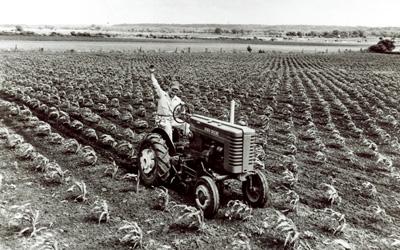
Description
In the early summer, before corn plants are big enough to shade the ground around them and fill in the rows, the farmer has to get rid of the weeds so they do not choke out the corn plants. In the 1940s, farmers worked the fields with a cultivator attached to a…
Field Workers Harvesting Sweet Corn in Grimes, Iowa, August 1946
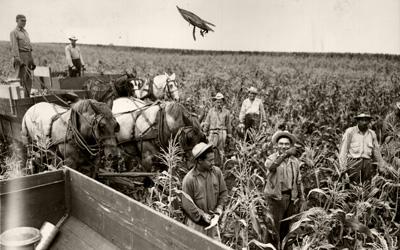
Description
For about five weeks in the summer, many people in Iowa enjoy fresh from the field sweet corn. In this photo, field workers are harvesting sweet corn for the Beaver Valley Canning Company (later called the Grimes Canning Company) on the farm of Jesse Taylor near Grimes, Iowa…
Number of Farms and Average Farm Size in Iowa from 1950 to 2014, 2015
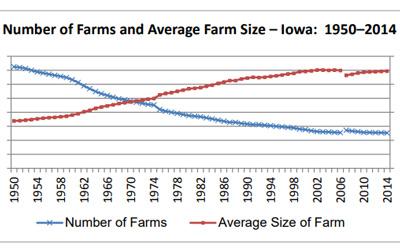
Description
This graph looks at the number of farms compared to the average farm size in Iowa from 1950 to 2014.
Corn for Grain Yield Map of Iowa, 2018
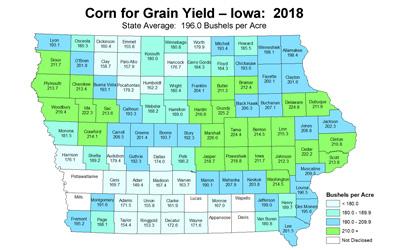
Description
Each year, the United States Department of Agriculture puts out statistics about what happened in agriculture that year. This map shows the average bushels of corn produced per acre for by county. Many variables impact the corn crop yield such as weather and soil conditions…
Gulls Following a Farmer on his Tractor, Date Unknown

Description
One of the things that has not changed about growing corn is the kind of work that happens. In the spring, farmers prepare the soil and plant the corn seeds. At the time of this photograph, many farmers used a plow to turn the soil over before they planted the seeds.…
"The Hawkeye Cultivator," 1863
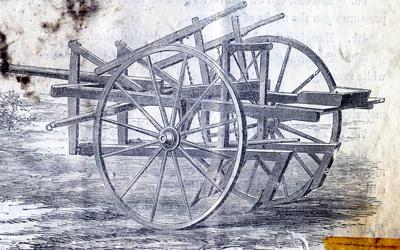
Description
The Hawkeye Cultivator was John Deere's first riding implement. Just like his original steel plow, the invention came about to serve a need. Many men were returning from the Civil War wounded and unable to walk behind an implement. Deere's Hawkeye Cultivator allowed men…
Gilpin Sulky Plow Patent, 1875
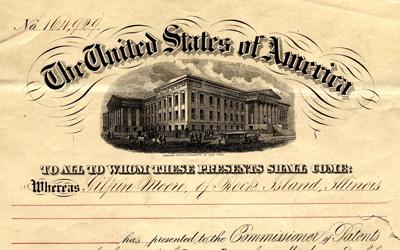
Description
When an inventor registers a patent for their invention, they have the right to produce and sell that invention for a certain number of years, and no one can copy their idea. Gilpin Moore received a patent for his invention in 1875, and then partnered with John Deere to…
“The Original Steel Plow” and John Deere, 1882
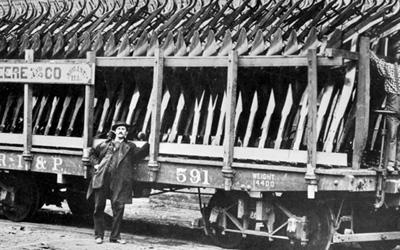
Description
In the mid-1800s, Iowans worked very hard to produce a corn crop in the thick prairie sod. In Illinois, our neighbor to the east, John Deere was working as a blacksmith when he had an amazing idea. More than 175 years later, the company he started is still an industry…
"A Short Interview" with John Deere, ca. 1886
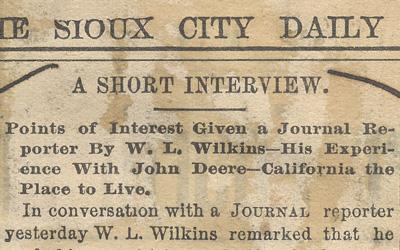
Description
W. L. Wilkings describes in this article in The Sioux City Daily a conversation he had with John Deere while the two were traveling to California on a train. This conversation happened shortly before Deere died in May 1886.
New Deal Gang Plow with Traction Engine Advertisement from John Deere, 1889
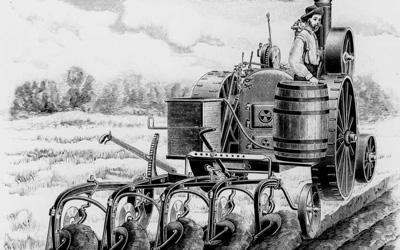
Description
It was not until 1918 that John Deere's company introduced a tractor. However, they started making implements for and even partnering first with steam engine manufacturers and then manufacturers of gasoline and kerosene tractors. This advertisement for a "gang…
Brochure about John Deere's Gilpin Sulky Plow, 1895
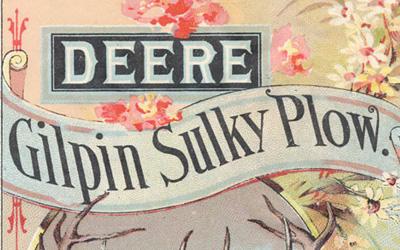
Description
Farm implements were designed to make work easier and allow a farmer to produce more each year. Companies had to work hard to earn the farmer's business. This brochure points out the strong features of the Gilpin Sulky Plow that John Deere manufactured.
Aerial View of the John Deere Tractor Company in Waterloo, Iowa, 1944

Description
In the late 1800s and early 1900s, farmers all over America turned to tractors with gasoline and diesel-powered engines. But it was not until 1918 that Deere & Company started producing them. Even then, it was under a different name because Deere & Company bought out…
Farmer Operating Corn Picker with John Deere Tractor, ca. 1945
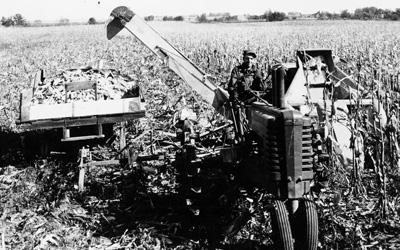
Description
While John Deere's original invention focused on plowing the land, Deere & Company expanded their product lines to include other parts of farming as well. Only four years after introducing their first John Deere brand tractor, the company introduced their first harvester…
Flowchart of U.S. Agricultural Supply Chain for Raw and Processed Products, 2009
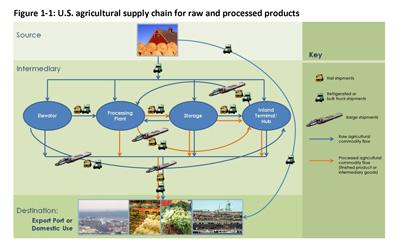
Description
This infographic shows the modes of transportation that raw and processed agricultural products travel from source to destination. It was featured in a study that looked at the infrastructure that the United States has in place to move agricultural goods from one way…
Flowchart Showing the Uses of Corn, 2009
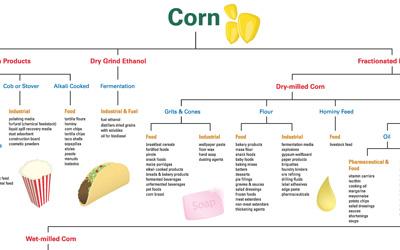
Description
Corn is used in a wide variety of products from frozen corn for people to eat to livestock feed to explosives to soaps, to ethanol and many more. The National Corn Growers Association created this chart in 2009 to help people understand all that corn goes into.
"Percent of Total U.S. Corn Exports by Country" Graph, 2017
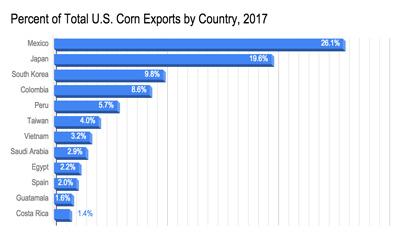
Description
The Foreign Agricultural Service department of the USDA published a chart showing the countries who received corn that was exported from the United States during the marketing year 2017 through 2018. This means the corn was grown during the summer of 2017, harvested…
"Compare... Cargo Capacity" Infographic, February 25, 2019
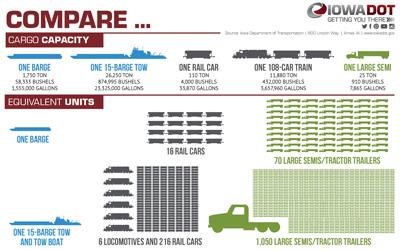
Description
This infographic was produced by the Iowa Department of Transportation in 2016 to show the volume of cargo capacity and the equivalent units of semi-trucks, rail cars and barges. For example, one 15-barge tow can haul the same amount of grain as 1,050 semi-truck trailers or…
Iowa Hog Lift to Japan, 1960

Description
The image shows hogs from Iowa being taken off a plane in Yamanashi Prefecture in Japan. There were 36 hogs sent from Iowa farms, with 35 arriving alive in Japan. Master Sergeant Richard Thomas inspired this outreach from Iowans to the citizens of Yamanashi, Japan.…
Lee Norris' Truck Loaded with Hogs, 1960
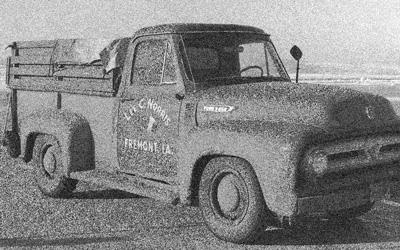
Description
Lee Norris operated a sale barn on his farm near Freemont, Iowa, for many years. In the 1950s, representatives from Japan would often attend the hog auctions at Mr. Norris' farm because of the high-quality purebred Hampshire hogs that he raised and sold. When Master Sgt.…
Additional Resources:
- A Tale of Two Corns
This two-page handout is from the National Corn Growers Association and it shows how corn from used in 2017. - Iowa Corn: Exports
This video focuses on the supply and demand of Iowa corn. - Iowa Nice Guy: Get Educated on Ethanol
This video looks at the uses and production of ethanol in Iowa. - "Norman Borlaug" on Iowa Public Television's Iowa Pathways
The webpage from Iowa Public Television includes text and images of the famous Iowan, Norman Borlaug, who impacted global agriculture, fed billions of people, won a Nobel Peace Prize and established the World Food Prize. - "My Family's Corn Farm"
This online book shows text and photos of an Iowa girl whose family grows corn. The story is told from girl's perspective with additional information about farming for adults. - John Deere 1927 Corn Picker
This one-minute video shows a 1927 John Deere corn picker in action. - Picking Corn with Horses
This one-minute video shows a farmer picking corn with the use of horses. - Harvesting Corn with Belgian Horses Pulling a Corn Binder
This three-minute video shows a farmer harvesting corn with the use of Belgian horses pulling a corn binder. - The Boy Who Changed the World by Andy Andrews
This book tells the story of how Norman Borlaug saved the lives of two billion people but would not have gotten to that point without the very important actions of other people. - Sweet Corn and Sushi by Lori Erickson
This book tells the story of how Iowa and Yamanashi became sister states. - Sweet Corn and Sushi Reading by Lori Erickson
The Greater Des Moines Sister Cities Commission presents Lori Erickson reading her book, Sweet Corn and Sushi. The children's book presents the story of the Iowa-Japan Hog Lift, in which the people of Iowa sent hogs and corn to Yamanashi Prefecture in 1960, after two typhoons devastated the region’s agricultural sector. Des Moines and Kofu, the capital of Yamanashi, became sister cities in 1959, one year before the hog lift. - The Commodity Chain of Corn
This interactive webpage is a visual representation of information on global corn production, sweet corn production, subsidies, ethanol, livestock feed, corn in food and U.S. corn exports. - "Branstad Asks for Support for Snow-Ravaged Japan Sister State" Article from The Des Moines Register
This article focuses on how Governor Terry Branstad asked Iowans to send money to Yamanashi, Japan, after heavy snow damaged roads and infrastructure in the winter of 2014.
Iowa Core Social Studies Standards (4th Grade)
Listed below are the Iowa Core Social Studies content anchor standards that are best reflected in this source set. The content standards applied to this set are elementary-age level and encompass the key disciplines that make up social studies for fourth-grade students.
| No. | Standard Description |
| SS.4.10. | Describe how societies have changed in the past and continue to change. |
| SS.4.12. | Using historical and/or local examples, explain how competition has influenced the production of goods and services. |
| SS.4.14. | Explain the reasons why the costs of goods and services rise and fall. |
| SS.4.21. | Analyze conflicting perspectives on historical and current events/issues. |
| SS.4.22. | Infer the purpose of a primary source and from that the intended audience. |
| SS.4.26. | Explain how Iowa’s agriculture has changed over time. |